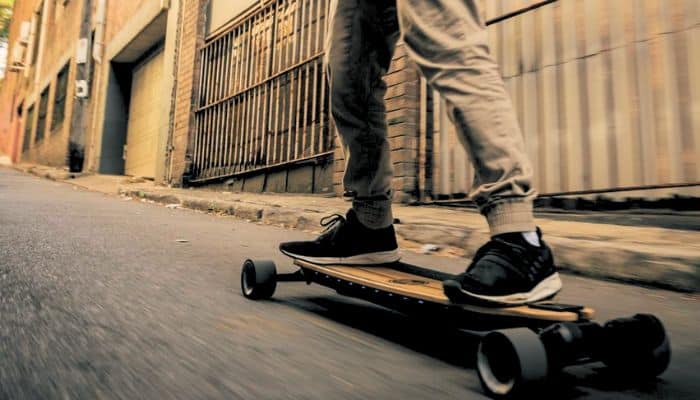Electric skateboarding, a thrilling blend of traditional skateboarding and technological innovation, has emerged as a popular activity for enthusiasts and commuters alike. This guide is designed to introduce beginners to the world of electric skateboarding, covering the basics of what it is, its benefits, and how to choose the right board.
Understanding Electric Skateboarding
Electric skateboarding involves a skateboard equipped with an electric motor, controlled by a handheld wireless remote. This modern twist on the classic skateboard allows for higher speeds, effortless uphill travel, and a unique riding experience. Unlike traditional skateboarding, electric skateboards offer a more accessible entry point for those who might not have the physical prowess or balance for manual skateboarding.
The Evolution of Skateboarding
The evolution from traditional to electric skateboarding represents a significant leap in technology and user experience. Traditional skateboarding, rooted in athleticism and skill, primarily serves as a sport or hobby. Electric skateboarding, on the other hand, extends its utility to practical transportation, making it an appealing option for a broader audience.
Benefits of Electric Skateboarding
Electric skateboarding offers several advantages, making it an attractive option for both recreation and commuting.
1. Ease of Use
One of the most significant benefits is its ease of use. The learning curve for electric skateboarding is generally less steep compared to traditional skateboarding. The electric motor assists in maintaining balance and control, making it more accessible for beginners.
2. Efficient Commuting
Electric skateboards are an efficient way to navigate urban environments. They are faster than walking, more flexible than bicycles in navigating crowded spaces, and environmentally friendly compared to cars. Their portability also makes them a convenient option for mixed-mode commuting, such as combining skateboarding with public transportation.
3. Fun and Excitement
Beyond practicality, electric skateboarding offers a unique and exhilarating experience. The sensation of gliding effortlessly at speed is a major draw for many enthusiasts. It combines the thrill of speed with the freedom of open-air travel.
4. Physical Fitness
While less physically demanding than traditional skateboarding, electric skateboarding still offers a form of physical exercise. It requires core strength to maintain balance and control, providing a moderate workout.
5. Eco-Friendly
Electric skateboards are a green mode of transportation. They produce no emissions, making them an environmentally friendly choice for short-distance travel.

Selecting the Right Electric Skateboard for Beginners
Choosing the right electric skateboard is crucial for beginners. Here are key factors to consider:
1. Board Type
Electric skateboards come in various shapes and sizes, each offering different riding experiences. For beginners, a longboard style is often recommended due to its stability and ease of control.
2. Motor Power and Speed
The motor’s power determines the skateboard’s speed and ability to climb hills. Beginners should start with a board that offers manageable speed and power to ensure safety and comfort while learning.
3. Battery Life and Range
Consider the skateboard’s battery life and range. For casual riders or short commutes, a standard battery may suffice. However, for longer commutes or extended use, look for a board with a longer range.
4. Weight and Portability
The weight of the board affects its portability. Lighter boards are easier to carry when not in use, an important consideration for those who plan to use their skateboard for commuting.
5. Durability and Build Quality
Durability is essential for longevity and safety. Look for boards made with high-quality materials and robust construction.
6. Price
Electric skateboards vary in price. Beginners should balance cost with quality, avoiding overly cheap models that may compromise on safety and durability.
Safety First: Essential Gear and Precautions
Safety should be your top priority when electric skateboarding, especially for beginners.
1. Protective Gear
Always wear appropriate protective gear. This includes a helmet, knee pads, elbow pads, and wrist guards. A helmet is non-negotiable; it’s crucial for protecting against head injuries.
2. Start Slow
Begin in a safe, open area free from traffic and obstacles. Get accustomed to the board’s speed and braking gradually. Don’t rush into high speeds until you’re comfortable and in control.
3. Be Aware of Your Surroundings
Always be aware of your surroundings. Watch for pedestrians, vehicles, and obstacles. Remember, you’re faster and quieter on an electric skateboard, which can surprise others.
4. Obey Traffic Laws
If you’re using your skateboard for commuting, obey all traffic laws. Use bike lanes where available and avoid pedestrian-only areas.

Basic Riding Techniques
Mastering basic riding techniques is crucial for a safe and enjoyable experience.
1. Stance and Balance
Find your comfortable stance – either regular (left foot forward) or goofy (right foot forward). Practice shifting your weight to steer and maintain balance. Your knees should be slightly bent to absorb shocks.
2. Accelerating and Braking
Learn to use the remote control effectively. Start with gentle acceleration and practice smooth braking. Sudden stops can throw you off balance.
3. Turning and Maneuvering
Practice turning by shifting your weight on the board. Start with wide turns and gradually work on tighter maneuvers as you gain confidence.
Maintenance and Care
Proper maintenance ensures the longevity and safety of your electric skateboard.
1. Regular Inspections
Regularly inspect your board for any signs of wear and tear, especially the wheels, trucks, and deck. Check for any loose components.
2. Battery Care
Take good care of the battery, as it’s the heart of your electric skateboard. Avoid extreme temperatures and always use the manufacturer-provided charger. Don’t overcharge the battery, and store it properly if not in use for extended periods.
3. Cleaning and Storage
Keep your board clean from dirt and debris. Store it in a dry, cool place to prevent any damage to the electrical components.
4. Software Updates
If your board has a companion app, keep it updated. Software updates can improve performance and safety features.
Learning and Community
Electric skateboarding is not just about the ride; it’s also about the community.
1. Join Local Groups
Join local electric skateboarding groups or online forums. They can be great resources for tips, advice, and group rides.
2. Continuous Learning
Keep learning and improving your skills. Watch tutorials, read blogs, and stay updated with the latest in electric skateboarding.
3. Share and Enjoy
Most importantly, enjoy the ride and share your experiences with others. Electric skateboarding can be a fun and exhilarating way to explore, commute, and connect with like-minded individuals.

